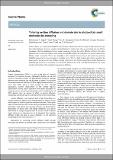Files in this item
Tailoring exciton diffusion and domain size in photovoltaic small molecules by processing
Item metadata
| dc.contributor.author | Sajjad, Muhammad Tariq | |
| dc.contributor.author | Zhang, Yiwei | |
| dc.contributor.author | Geraghty, Paul B. | |
| dc.contributor.author | Mitchell, Valerie D. | |
| dc.contributor.author | Ruseckas, Arvydas | |
| dc.contributor.author | Blaszczyk, Oskar | |
| dc.contributor.author | Jones, David J | |
| dc.contributor.author | Samuel, Ifor David William | |
| dc.date.accessioned | 2020-04-18T23:32:31Z | |
| dc.date.available | 2020-04-18T23:32:31Z | |
| dc.date.issued | 2019-04-19 | |
| dc.identifier | 258562913 | |
| dc.identifier | 5406a692-bbc0-4185-ac7d-1d02bfc21fbb | |
| dc.identifier | 000474154900007 | |
| dc.identifier | 85068522532 | |
| dc.identifier.citation | Sajjad , M T , Zhang , Y , Geraghty , P B , Mitchell , V D , Ruseckas , A , Blaszczyk , O , Jones , D J & Samuel , I D W 2019 , ' Tailoring exciton diffusion and domain size in photovoltaic small molecules by processing ' , Journal of Materials Chemistry C , vol. In press . https://doi.org/10.1039/C9TC00951E | en |
| dc.identifier.issn | 2050-7526 | |
| dc.identifier.other | ORCID: /0000-0001-9114-3522/work/57330838 | |
| dc.identifier.uri | https://hdl.handle.net/10023/19821 | |
| dc.description | Funding: European Research Council (grant 321305); UK EPSRC for equipment grant (EP/L017008/1) and (EP/M508214/1) (OB). | en |
| dc.description.abstract | Exciton diffusion is an important part of light harvesting in organic photovoltaics (OPVs) because it enables excitons to reach the interface betweeen donor and acceptor and contribute to the photocurrent. Here we used simple and cost-effective techniques of thermal annealing and solvent vapour annealing to increase the exciton diffusion coefficient and exciton diffusion length in two liquid crystalline electron donor materials BQR and BTR. We found that the three-dimensional exciton diffusion length increased to ~40 nm upon annealing in both materials. Grazing-incidence wide angle X-ray scattering (GIWAXS) measurements show an increase of crystallite size to ~37 nm in both materials after thermal annealing. We determined an average domain size of these materials in the blends with PC71BM using diffusion-limited fluorescence quenching and found that it increased to 31 nm in BTR PC71BM blends and to 60 nm in BQR PC71BM blends. Our results provide understanding of how annealing improves device efficiency. | |
| dc.format.extent | 8 | |
| dc.format.extent | 677130 | |
| dc.language.iso | eng | |
| dc.relation.ispartof | Journal of Materials Chemistry C | en |
| dc.subject | QC Physics | en |
| dc.subject | TK Electrical engineering. Electronics Nuclear engineering | en |
| dc.subject | DAS | en |
| dc.subject | SDG 7 - Affordable and Clean Energy | en |
| dc.subject.lcc | QC | en |
| dc.subject.lcc | TK | en |
| dc.title | Tailoring exciton diffusion and domain size in photovoltaic small molecules by processing | en |
| dc.type | Journal article | en |
| dc.contributor.sponsor | EPSRC | en |
| dc.contributor.sponsor | European Research Council | en |
| dc.contributor.institution | University of St Andrews. School of Physics and Astronomy | en |
| dc.contributor.institution | University of St Andrews. Condensed Matter Physics | en |
| dc.contributor.institution | University of St Andrews. Centre for Biophotonics | en |
| dc.identifier.doi | 10.1039/C9TC00951E | |
| dc.description.status | Peer reviewed | en |
| dc.date.embargoedUntil | 2020-04-19 | |
| dc.identifier.grantnumber | ep/l017008/1 | en |
| dc.identifier.grantnumber | en |
This item appears in the following Collection(s)
Items in the St Andrews Research Repository are protected by copyright, with all rights reserved, unless otherwise indicated.

